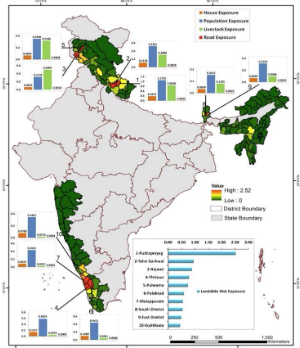

11th March 2023 (7 Topics)
Context
According to the India Meteorological Department’s Statement of Climate of India 2022, heavy rain, floods and landslides claimed 835 lives in the country in the year 2022.
About Landslides
- Landslides are natural disasters occurring mainly in mountainous terrains where there are conducive conditions of soil, rock, geology and slope.
- A sudden movement of rock, boulders, earth or debris down a slope is termed as a landslide.
- Classification: Landslides are broadly classified based on the
- type of materials involved (rock, debris, soil, loose mud)
- type of movement of the material (fall, topple, slide, rotational slide or translational slide)
- type of flow of the material
- Another category is of landslides that spread laterally. Landslides mapped in the ISRO atlas are mainly event-based and season-based.
What causes landslides?
- Natural factors: Natural causes that trigger it include heavy rainfall, earthquakes, snow melting and undercutting of slopes due to flooding.
- Anthropogenic factors: Landslides can also be caused by anthropogenic activities such as excavation, cutting of hills and trees, excessive infrastructure development, and overgrazing by cattle.
- Other influential factors: Some of the main factors that influence landslides are lithology, geological structures like faults, hill slopes, drainage, geomorphology, land use and land cover, soil texture and depth, and weathering of rocks.
Proneness of India to landslides
- India is considered among the top five landslide-prone countries globally. In India, at least one death per 100 sq km is reported in a year due to a landslide event.
- Himalayas and the Western Ghats remaining highly vulnerable because rainfall variability pattern is the single biggest cause for landslides.
- North-Eastern states: Nearly half of the country’s landslide-prone area (0.18 sq km) is located in the states of Assam, Arunachal Pradesh, Sikkim, Meghalaya, Mizoram, Manipur, Tripura and Nagaland.
What factors influence landslides?
- Main factors: The main factors that influence landslides are lithology, geological structures like faults, hill slopes, drainage, geomorphology, land use and land cover, soil texture and depth, and weathering of rocks. All these are factored in when a landslide susceptibility zone is earmarked for planning and making predictions.
- Natural causes that trigger it include heavy rainfall, earthquakes, snowmelting and undercutting of slopes due to flooding.
- Anthropogenic activities: Landslides can also be caused by anthropogenic activities such as excavation, cutting of hills and trees, excessive infrastructure development, and overgrazing by cattle.
Way forward
- Environmental Impact assessment: There should be proper implementation of Environmental impact assessment norms before initiating mining or dam construction.
- Micro Zoning procedures: there should be the adoption of landslide micro zoning procedures for mountainous and other highly vulnerable regions.
- Locally trained Manpower: there should be involvement of locally available trained manpower to intensify the hazard reduction and public awareness programs.
More Articles



